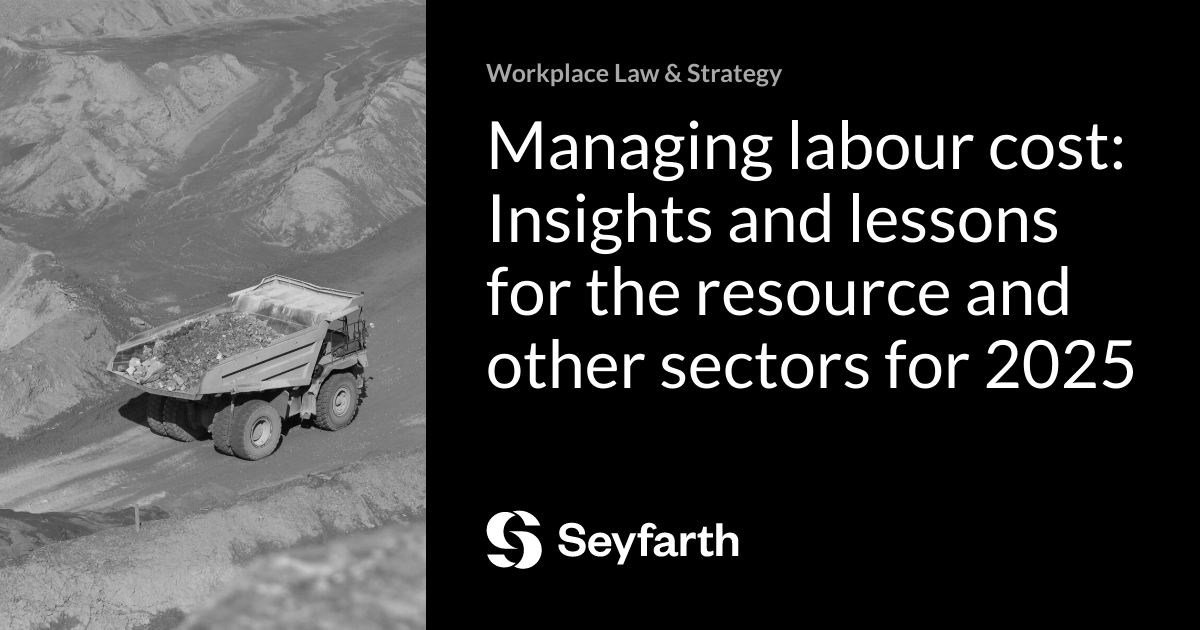Employers in the resources sector are watchful of legal developments in 2025 that could significantly impact their labour strategies, particularly their ability to engage, utilise and remove contractors. With non-labour costs rising and commodity prices remaining below their 2022 peaks, companies are under pressure to find ways to reduce labour costs.
In this two-part series, I will look at three cases before the Australian courts and Fair Work Commission, which have the potential to significantly impact how employers in the resources sector navigate their labour arrangements.
Labour hire and the ‘same job, same pay’ conundrum
One common strategy to reduce labour costs and maximise flexibility has been to replace higher-cost workforces, in full or in part, with labour hire. However, this approach has become more challenging due to a number of regulated labour hire arrangement orders being made in the coal mining sector. These orders, known as ‘same job, same pay’ orders, require labour hire employers to pay employees the same rates as the employees of the host and generally lead to increased labour costs.
The Fair Work Commission is set to decide whether to issue same job, same pay orders requiring BHP group companies – OS MCAP Pty Ltd (OS Production) and OS ACPM Pty Ltd (OS Maintenance) – to pay their employees the same rates as those paid by their client, BHP Mitsubishi Alliance (BMA), at several coal mines in Queensland. The Mining and Energy Union argues that OS Production and OS Maintenance supply employees to BHP to perform work for it, while BHP and the OS entities claim they provide a service, not just labour. This distinction is crucial because if the Commission rules that they are providing a service, it cannot issue a ‘same job, same pay’ order.
It is hoped that this case will provide some guidance on the distinction between a provider of labour and a provider of services. A broad interpretation of a ‘provider of labour’ in this case could result in unions seeking further same job, same pay orders against companies traditionally seen as service providers. This could have ramifications for any service provider regardless of sector.
Reducing contractors before direct employee redundancies
As margins tighten, companies may need to reduce direct employee numbers, potentially due to changes in rosters or operational fleet reductions. Employers are keenly watching a High Court case involving Helensburgh Coal Pty Ltd, which is appealing a decision of the Full Court of the Federal Court that it could not use the genuine redundancy defense in unfair dismissal claims because it had not reduced its reliance on contractors before terminating direct employees.
The genuine redundancy defence is not available if it is reasonable to redeploy employees. The Full Court found that the Fair Work Commission should consider whether an employer could free up work for redeployment by reducing reliance on contractors. Helensburgh argues that the Commission should not have the authority to effectively require employers to terminate existing staffing arrangements to free up work for otherwise redundant employees.
So, what impact will this case potentially have on employers? Industries that rely heavily on contractor workforces, such as the resources sector, are concerned that they may be required to cut contractor numbers before reducing their own workforce, even if contractors provide a more commercial solution. The High Court’s decision will provide guidance on whether businesses must direct their suppliers to reduce their headcounts before making their own employees redundant.
The outcomes of these cases will have significant implications for resource sector employers. They will provide clarity on the distinction between labour and service providers and whether companies must reduce contractor numbers before making direct employee redundancies. As these decisions unfold, employers will need to adapt their labour strategies to comply with new regulatory environment to maintain economic viability.
In part 2, I’ll focus on a recent Fair Work Commission case which may reshape how employers approach enterprise bargaining.
Subscribe to receive the next Workplace Law & Strategy blog direct to your inbox.
“With approximately 900 lawyers across 17 offices, Seyfarth Shaw LLP provides advisory, litigation, and transactional legal services to clients worldwide.”
Please visit the firm link to site






